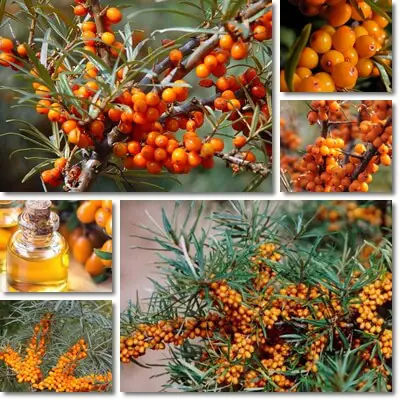As we start to see a return to our roots, foods long gone from our modern diets are being rediscovered and making a remarkable comeback thanks to an increased interest in health-conscious eating. Sea-buckthorn berries are one such lost food made popular once again due to their incredible therapeutic potential.
The bright colored orange berries are a rich source of carotenoid antioxidants, but also vitamin C and flavonol antioxidants. Both the fruit pulp and seeds are high in vitamin E and a source of vitamin K, potassium, manganese, molybdenum, copper, chromium, iron, selenium and zinc. Sea-buckthorn berry and seed oils are rich in unsaturated fatty acids, vitamin E and carotenoid antioxidants, hence their orange to yellow color.
Uses of sea-buckthorn berries and preparations range from cosmetic to therapeutic, with emphasis on their regenerative, anti-inflammatory and immuno-stimulating properties and their antioxidant action.
What is sea buckthorn?
Sea-buckthorn is a genus of thorny, extensively ramified, hardy shrubs with edible, bright orange fruits with good nutritional value and therapeutic properties. Sea-buckthorns are present throughout the Northern hemisphere, from Canada to all of Europe to Russia, Mongolia and China. They can be found growing naturally in a variety of habitats ranging from mountain slopes down to the sea coast, with large populations thriving in sunny river banks, but also salty, sandy and semi-arid areas.
The presence of sea-buckthorn in some rather inhospitable areas such as the sea coast or semi-desert areas has led to popular alternative names such as seaberry and sandthorn. Species include Hippophae rhamnoides, also known as the common sea-buckthorn, Hippophae goniocarpa, H tibetana, H. gyantsensis, H. salicifolia and H. neurocarpa, and subspecies.

What is sea buckthorn used for?
- Berries medicinal uses: fruit and seed oil (sea-buckthorn berry oil, seed oil), fruit juice, tea and syrup, macerates, tinctures, extracts and nutritional supplements are used for nutritional supplementation, reducing excess stomach acid (in GERD), dry eyes and skin (xerosis), arthritis pain management, skin ulcers, canker sores, acne, even for radiation damage therapy and more.
- Berries cosmetic uses: sea-buckthorn berry and seed oil are common active ingredients in eye creams, face creams, reparative, regenerative or anti-aging face, neck and hand creams, body lotions, face toners, shampoos, reparative conditioners etc.
- Berries culinary uses (skin and pulp): tart and sweetened sauces, jam, jelly, puree, tea, juice, syrup, pie and pastry fillings, or non-toxic dye for at-home use.
- Berry seeds uses: production of oil for cosmetic and therapeutic use (arthritis, rheumatism, dry skin, wrinkles, acne, mouth sores or canker sores, skin ulcerations etc.). The seed cake left over from oil production can be used as animal fodder.
- Whole plant: soil stabilization, combating soil erosion, restoring vegetation density, improving soil quality through nitrogen fixation and moisture retention, landscaping and various ornamental uses (e.g. flower arrangements), crop sheltering (e.g. protection from strong winds), use as animal food etc.
What do sea buckthorn berries look like?
Sea-buckthorn berries are the fruits of the plant with the same name. Despite the name, they are not true berries, but rather drupes like sweet and sour cherries, peaches, nectarines and olives. Most species of the plant produce small, bright orange-colored berry-like fruits, sometimes also pale yellow.
The fruits are roundish or egg-shaped and have a thin peel with a meaty, somewhat juicy, pulp and one hard seed each. At the end opposite to the stem, there are remnants of sepals visible on each fruit. Sea-buckthorn berries grow in such a closely-knit richness they severely weight down branches. The plant is a shrub or tree-sized plant growing anywhere from 1 to 6 meters in height, and is extensively ramified and typically thorny. Sea-buckthorn is a hardy species, tolerating and thriving in alpine and sub-alpine regions down to salty, sandy sea coast areas and dry semi-desert conditions.
What does sea buckthorn taste like?
Sea-buckthorn does not taste like the type of fruit we are used to eating nowadays. This is probably the main reason for its lack of popularity among the general population. Sea-buckthorn berries taste tart and astringent as a result of the organic acids such as malic acid, ascorbic acid, quinic acid and other acids in the fruit pulp, but also oily due to the high content of oil in both the seeds and pulp. To improve their taste, sea-buckthorn berries are best left on the plant until the first frosts – freezing temperatures blet the fruit, that is, soften and somewhat decay them, achieving a reduced astringency that makes the berries taste more palatable. They are otherwise not flavorful. The fruits are as hardy as the plant itself and can stay on the branch all winter.

Sea-buckthorn therapeutic properties
- Antioxidant and anti-aging, promoting tissue damage repair and exerting a skin tightening action
- Anti-inflammatory, antiviral and antimicrobial
- Regenerative, supporting tissue repair and wound healing
- Pain-relieving (e.g. anti-arthritic properties)
- General tonic with restorative properties
- Digestive aid with soothing properties, effective in acid reflux disease
- Anti-hypertensive and antihyperlipidemic
- Diuretic (berry tea and juice)
- Antiplatelet properties
- Radioprotective activity
- Vitaminizing and functional food
- From organic agriculture
Note: Sea-buckthorn is a hardy plant and does not typically require herbicide or pesticide treatment.
What are sea-buckthorn berries good for?
Sea-buckthorn berries and preparations made from them, including oil, juice, tea and other preparations have excellent therapeutic properties and provide a range of benefits, including:
- Vitaminizing action: Sea-buckthorn berries are a good source of vitamins A, C, E, K, B vitamins (B1, B2, B3, B5, B6 and B9), biotin, chromium, copper, iron, manganese, molybdenum and potassium and contain smaller amounts of magnesium, selenium and zinc.
- Benefits for dry eyes. Daily supplementation with sea-buckthorn fruit oil helps improve symptoms of dry eye.
- Other benefits for eyesight. Rich in carotenoid antioxidants, beta-carotene, lutein, zeaxanthin and also lycopene, sea-buckthorn berries promote the physical health of the eye and contribute to visual acuity and overall good eyesight. Can be considered for supplementation for age-related macular degeneration.
- Benefits for endometriosis: Animal studies on supplementation with sea-buckthorn fruit oil and St. John’s wort show a reduction in endometrial implants (tissues grown outside the uterus) and adhesions.
- Other benefits for women: Studies show 1-month supplementation with 100 g of fresh or dried sea-buckthorn berries has a beneficial effect on cardiovascular disease risks in women.
- Benefits for high blood pressure. With 300-380 mg of potassium per 100 g, the fruits have anti-hypertensive benefits.
- Good for high cholesterol. As a source of healthy unsaturated fats, sterols, vitamin B3 and antioxidants such as vitamin C, sea-buckthorn berries contribute to healthier cholesterol numbers.
- Anti-ulcerogenic action. Constituents in sea-buckthorn such as the pro-vitamin A antioxidant beta-carotene, vitamin E, beta-sitosterol, fatty acids and more have a protective action against ulcers and promote healing of existing ulcers such as canker sores (mouth ulcers) and stomach ulcers caused by increased stomach acidity (GERD or acid reflux disease).
- Liver protective properties. Supplementation with sea-buckthorn extract has been shown to improve liver health parameters.
- Help dislodge throat phlegm: Sea-buckthorn berries and also tea and juice are astringent due to a high content of organic acids and can help get rid of throat phlegm.
- Benefits for skin. Sea-buckthorn berries, berry oil and extracts speed healing of wounds, soothe burns and promote healing, soften and nourish skin and calm irritation. The fruits have also exhibited anti-tumor properties with relation to the skin. Topical use can help improve eczema and possibly also psoriasis symptoms.
- Anti-aging action. Owed to high amounts of vitamin C which stimulates collagen production for improved skin elasticity, vitamin A which promotes tissue regeneration and repair, vitamin E which has antioxidant effects and contributes to skin cell membranes, helping skin cells better retain moisture, organic acids which tighten skin and unsaturated fatty acids with antioxidant properties.
- Potential benefits for arthritis. Consumption of the berries and topical use of the berry oil can help lower inflammation and swelling associated with arthritis, improving mobility and reducing pain.
- Immune system boosting action. Rich in vitamin C, sea-buckthorn berries have strong anti-inflammatory and antioxidant effects and increase the immune system response by enhancing the activity of various types of white blood cells. A serving of 100 g of the fresh, ripe berries provides and estimated of 700 mg of vitamin C, and up to 1.5 of the vitamin.
- Anticancer properties. Studies show sea-buckthorn berries, extracts and preparations have a range of anticancer properties and exhibit protective effects with regards to skin, mucous membranes, digestive tract, liver and even breast cancer.
- Radioprotective effects. Studies show sea-buckthorn to hold some degree of radioprotective effects as a result of the immune system-boosting action of the fruits and antioxidant properties.
What are the side effects of sea-buckthorn berries?
Studies and empirical data on sea-buckthorn berries and preparations made from them show they are safe for consumption, with little to no side effects. Sea-buckthorn in pregnancy appears to be safe and has not been found to cause malformations to the embryo or fetus, or negatively impact pregnancy development. However, the fruit and all plant preparations are contraindicated in cases of allergy to sea-buckthorn.
Excessive consumption of tea and juice, in combination with hypertension medication, can cause blood pressure to drop too much, which is why caution is in order when using the plant to target hypertension. Lastly, excessive and long-term consumption of the berries and berry preparation can cause a harmless orange coloration of the skin known as carotenodermia or carotenosis. Discontinuing consumption oversees skin return to its normal color.
